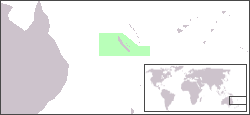
Back Geografía de Nueva Caledonia Spanish Géographie de la Nouvelle-Calédonie French ახალი კალედონიის გეოგრაფია Georgian Geografia Nowej Kaledonii Polish Geografia da Nova Caledônia Portuguese География Новой Каледонии Russian Географія Нової Каледонії Ukrainian
 Map of New Caledonia | |
 | |
| Geography | |
|---|---|
| Location | Pacific Ocean |
| Coordinates | 21°21′03″S 165°25′56″E / 21.350781°S 165.432129°E |
| Area | 18,575 km2 (7,172 sq mi) |
| Area rank | 53rd |
| Length | 350 km (217 mi) |
| Width | 70 km (43 mi) |
| Highest elevation | 1,628 m (5341 ft) |
| Highest point | Mont Panié |
| Administration | |
France | |
| Overseas departments and territories of France | New Caledonia |
| Largest settlement | Nouméa (pop. 91,386) |
| Demographics | |
| Population | 208,709 (2004) |
| Pop. density | 12.75/km2 (33.02/sq mi) |
| Ethnic groups | Melanesian 44.6%, European 34.5%, Wallisian 9.1%, Tahitian 2.7%, Indonesian 2.6%, Vietnamese 1.4%, Ni-Vanuatu 1.2%, other (Filipino) 3.9% |
The geography of New Caledonia[1] (Nouvelle-Calédonie), an overseas collectivity of France located in the subregion of Melanesia, makes the continental island group unique in the southwest Pacific. Among other things, the island chain has played a role in preserving unique biological lineages from the Mesozoic. It served as a waystation in the expansion of the predecessors of the Polynesians, the Lapita culture. Under the Free French it was a vital naval base for Allied Forces during the War in the Pacific.
The archipelago is located east of Australia, north of New Zealand, south of the Equator, and just west of Fiji and Vanuatu. New Caledonia comprises a main island, Grande Terre, the Loyalty Islands, and several smaller islands. Approximately half the size of Taiwan, the group has a land area of 18,575.5 square kilometres (7,172.0 square miles). The islands have a coastline of 2,254 km (1,401 mi). New Caledonia claims an exclusive fishing zone to a distance of 200 nmi or 370 km or 230 mi and a territorial sea of 12 nmi (22 km; 14 mi) from shore.[2]
New Caledonia is one of the northernmost parts of an almost entirely (93%) submerged continent called Zealandia which rifted away from Antarctica between 130 and 85 million years ago (mya), and from Australia 85–60 mya. (Most of the elongated triangular continental mass of Zealandia is a subsurface plateau. New Zealand is a mountainous above-water promontory in its center, and New Caledonia is a promontory ridge on the continent's northern edge.) New Caledonia itself drifted away from Australia 66 mya, and subsequently drifted in a north-easterly direction, reaching its present position about 50 mya.[3] Given its long stability and isolation, New Caledonia serves as a unique island refugium—a sort of biological 'ark'—hosting a unique ecosystem and preserving Gondwanan plant and animal lineages no longer found elsewhere.[4][5][6][7][8]
- ^ Previously known officially as the "Territory of New Caledonia and Dependencies" (French: Territoire de la Nouvelle-Calédonie et dépendances), then simply as the "Territory of New Caledonia" (French: Territoire de la Nouvelle-Calédonie), the official French name is now only Nouvelle-Calédonie (Organic Law of 19 March 1999, article 222 IV — see "Archived copy" (PDF). Archived from the original (PDF) on 2007-06-14. Retrieved 2007-06-14.
{{cite web}}: CS1 maint: archived copy as title (link)). French courts often continue to use the appellation Territoire de la Nouvelle-Calédonie. - ^ Kowasch M. and Batterbury, S.P.J. (eds.). 2024. Geographies of New Caledonia-Kanaky: environments, politics and cultures. Springer Open Access. http://doi.org/10.1007/978-3-031-49140-5
- ^ Boyer & Giribet 2007: 355
- ^ "New Caledonia has long been considered a Gondwanan refuge where archaic groups have survived for 80Ma." "New Caledonia: a very old Darwinian island?" Philippe Grandcolas,1* Jérôme Murienne, et al., Philos Trans R Soc Lond B Biol Sci. 2008 October 27; 363(1508): 3309–3317.
- ^ a window into the unique evolutionary history of this part of the world. Initially this biota lived along the New Zealand-New Caledonia coast of Gondwana, but following Cretaceous breakup of this southern supercontinent the fossils record terrestrial and marine evolution on and around the New Zealand "ark" set adrift in the Southwest Pacific." See HAYWARD B.W. (2009).- Protecting fossil sites in New Zealand Archived 2011-09-28 at the Wayback Machine.- In: LIPPS J.H. & GRANIER B.R.C. (eds.), PaleoParks – The Protection and conservation of fossil sites worldwide.- Carnets de Géologie / Notebooks on Geology, Brest, 2009
- ^ for scholarly usage of the exact term "biological ark" in context of the Gondwanan breakup: "This globally significant ‘biological ark’, is attributed to Australia's long geographic isolation from other parts of the world." "Potential of ecotourism to protect natural remnant areas within the urban environment" Fiona Prince The University of Western Australia, Department of Environmental Engineering, 2002
- ^ At the end of Jurassic (135 My), Gondwana started to break apart. The oldest grounds of current New Caledonia were then located on the eastern margin of this continent as part of the Australian block. Towards the end of Cretaceous, about 85 million years ago, this old New Caledonia broke away and so did New Zealand. New-Caledonia was then isolated... As a result, New Caledonia is now a kind of "Jurassic Park" particularly with regards to its vegetation which is highly endemic and which has kept archaic characteristics." Gondwana super-continent. Archived 2011-09-28 at the Wayback Machine
- ^ Jean-Jacques Espirat, author of Étude géologique de régions de la Nouvelle Calédonie and member of the Bureau de Recherches Geologiques et Minieres compares it to Noah's Ark: "La Grande Terre de la Nouvelle-Calédonie s'est séparée il y a 70 millions d'années (au Crétacé terminal) du continent de Gondwana (groupant à l'origine les terres qui se sont séparées pour former l'Australie, l'Antarctique, l'Amérique du Sud, l'Inde, Madagascar et l'Afrique). Telle l'Arche de Noé cette Nouvelle Calédonie de la fin du Crétacé embarquait la flore de cette époque." La faune et la flore de Nouvelle-Calédonie. (French)
© MMXXIII Rich X Search. We shall prevail. All rights reserved. Rich X Search